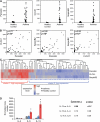T-helper type 2-driven inflammation defines major subphenotypes of asthma
- PMID: 19483109
- PMCID: PMC2742757
- DOI: 10.1164/rccm.200903-0392OC
T-helper type 2-driven inflammation defines major subphenotypes of asthma
Erratum in
- Am J Respir Crit Care Med. 2009 Oct 15;180(8):796
Abstract
Rationale: T-helper type 2 (Th2) inflammation, mediated by IL-4, IL-5, and IL-13, is considered the central molecular mechanism underlying asthma, and Th2 cytokines are emerging therapeutic targets. However, clinical studies increasingly suggest that asthma is heterogeneous.
Objectives: To determine whether this clinical heterogeneity reflects heterogeneity in underlying molecular mechanisms related to Th2 inflammation.
Methods: Using microarray and polymerase chain reaction analyses of airway epithelial brushings from 42 patients with mild-to-moderate asthma and 28 healthy control subjects, we classified subjects with asthma based on high or low expression of IL-13-inducible genes. We then validated this classification and investigated its clinical implications through analyses of cytokine expression in bronchial biopsies, markers of inflammation and remodeling, responsiveness to inhaled corticosteroids, and reproducibility on repeat examination.
Measurements and main results: Gene expression analyses identified two evenly sized and distinct subgroups, "Th2-high" and "Th2-low" asthma (the latter indistinguishable from control subjects). These subgroups differed significantly in expression of IL-5 and IL-13 in bronchial biopsies and in airway hyperresponsiveness, serum IgE, blood and airway eosinophilia, subepithelial fibrosis, and airway mucin gene expression (all P < 0.03). The lung function improvements expected with inhaled corticosteroids were restricted to Th2-high asthma, and Th2 markers were reproducible on repeat evaluation.
Conclusions: Asthma can be divided into at least two distinct molecular phenotypes defined by degree of Th2 inflammation. Th2 cytokines are likely to be a relevant therapeutic target in only a subset of patients with asthma. Furthermore, current models do not adequately explain non-Th2-driven asthma, which represents a significant proportion of patients and responds poorly to current therapies.
Figures





Comment in
-
Magic bullets: the new goal for asthma.Am J Respir Crit Care Med. 2009 Sep 1;180(5):383-4. doi: 10.1164/rccm.200905-0788ED. Am J Respir Crit Care Med. 2009. PMID: 19700565 No abstract available.
-
Molecular Th2 phenotypes of asthma: new biomarker or NO?Am J Respir Crit Care Med. 2010 Feb 15;181(4):419; author reply 419. doi: 10.1164/ajrccm.181.4.419. Am J Respir Crit Care Med. 2010. PMID: 20130148 No abstract available.
References
-
- Wills-Karp M, Luyimbazi J, Xu X, Schofield B, Neben TY, Karp CL, Donaldson DD. Interleukin-13: central mediator of allergic asthma. Science 1998;282:2258–2261. - PubMed
-
- Humbert M, Durham SR, Kimmitt P, Powell N, Assoufi B, Pfister R, Menz G, Kay AB, Corrigan CJ. Elevated expression of messenger ribonucleic acid encoding IL-13 in the bronchial mucosa of atopic and nonatopic subjects with asthma. J Allergy Clin Immunol 1997;99:657–665. - PubMed
-
- Wenzel S, Wilbraham D, Fuller R, Getz EB, Longphre M. Effect of an interleukin-4 variant on late phase asthmatic response to allergen challenge in asthmatic patients: results of two phase 2a studies. Lancet 2007;370:1422–1431. - PubMed
Publication types
MeSH terms
Substances
Grants and funding
LinkOut - more resources
Full Text Sources
Other Literature Sources
Medical
Molecular Biology Databases

